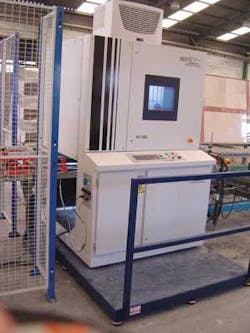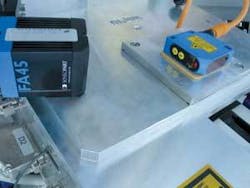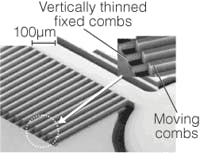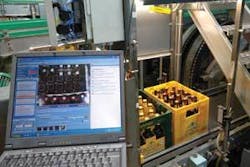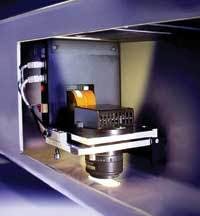Snapshots
Vision system speeds marble sorting
The ability to classify materials based on color or visual appearance creates a quality-control limitation in many manufacturing sectors, including the sorting of materials such as wood veneer and marble. When sorting is performed manually, it is subjective and prone to error. To automate the task, Asiris Vision Technologies (San Sebastián, Spain; www.asiristech.com) has developed Clastone, a technology that the company says can reproduce human behavior in color-classification tasks. In real time and using a neural network, it can identify classification criteria such as color, texture, and position of visual faults and can locate anomalous colors representative of faults in certain materials.
Traditional sorting technologies may rely on lasers and CCD cameras or matching technologies may be used; these are easy to use and can be very accurate but are unsatisfactory or not feasible on heterogeneous materials. To overcome the limitations, Asiris has developed the AVT-2000, the first inspection system for the marble industry that automates all the quality-control tasks and shade classification. Its vision system can inspect marble tiles ranging from 150 × 300 to 650 × 650 mm. The color module uses a Camera Link camera from TVI Vision (Helsinki, Finland; www.tvivision.com), custom fluorescent illumination with feedback control loop, and a frame grabber from Bitflow (Woburn, MA, USA; www.bitflow.com). A shade module allows automatic classification on the basis of user-defined shades; the fault module detects surface and edge defects; and a geometric module performs geometric analysis of color images.
Vision sensor checks color LED displays
Color LEDs are a standard element of many consumer and industrial electronic displays, but engineers need a reliable and affordable method for automating the testing of the LEDs during production. SensoPart Industriesensorik (Pontiac, MI, USA; www.sensopart.com), maker of sensors for industrial applications, recognized this need during the production of its industrial light barriers and photoelectric proximity switches, some of which are equipped with a control panel consisting of a color touch pad panel with seven integrated LEDs. The operability and correct color of each LED had to be checked visually, and automating the process proved difficult because a traditional color sensor could not detect self-luminous objects. Consequently, the company developed the FA 45 vision sensor to monitor the entire control panel of the proximity switch at once, checking function and color of all LEDs.
Now available on the market, the FA 45 vision sensor incorporates a CCD camera with electronics, white-light LEDs, M12 sensor connector, PLC compatible I/O and data interfaces, and aluminium/plastic housing.
Microscanner images at high speed
Researchers at the University of California at Berkeley’s Microfabrication Laboratory (Berkeley, CA, USA; microlab.berkeley.edu) have fabricated a MEMS-based microscanner that can rotate a mirror 24,000 times a second with great precision. According to researchers Hyuck Choo and David Garmire, applications range from a heads-up display that projects a video image onto the retina to advanced endoscopy tools outfitted with onboard CT scanners for 3-D medical imaging. Says Choo, “Our method involves only a few processing steps and uses only tools that are conventional for processing integrated circuits.”
The microscanners were built in the Sensor and Actuator Center. Their mechanical structures form an array of interlocked combs: one set is fixed to the surface of the wafer while the other can move when driven by a voltage. A mirror actuated by the comb drive can be positioned to scan a digital image or steer a laser. The researchers are building MEMS-based phase-shifting interferometers that measure transient phenomena such as cell growth.
Bottling inspection guaranteed by vision
Customer satisfaction is a decisive factor in the face of tough competition in the brewery business. Ottakringer Brauerei (Vienna, Austria; www.ottakringer.com) needed to guarantee that packaging units contained the full number of defect-free products to prevent customer complaints. Ottakringer contacted the image-processing department of Schmachtl (Linz, Austria; www.schmachtl.at), which determined production automation needs and priorities. To allow the brewery to develop an in-house solution, Schmachtl provided a test unit based on a Checker 101 vision sensor from Cognex (Natick, MA, USA; www.cognex.com), along with advice, giving the brewery’s maintenance team the flexibility to set up the checking station themselves.
Initially, each box of cans was passed along a conveyor belt equipped with the sensor to determine whether it contained 24 correctly inserted cans before the box is shrink-wrapped. Based on improved production flow of the cans, the next step was to introduce a completeness check on beer crates. The system now automatically adjusts to different product lines, checking whether an 18-, 20-, or 24- bottle crate is on the line. The checking station operates on a two- to three-shift-per-day basis and inspects beer crates at a rate of approximately one per second.
System boosts web inspection
The growing quality requirements of reprocessing mills and end-product users are pushing web-inspection system developers to increase the spatial and gray-scale resolutions of their systems. Normally, a single-camera solution would not be able to find the variety of defects that mills must identify, and, therefore several cameras with dedicated software have been used. To meet this challenge, ABB, Process Industry (Helsinki, Finland; www.abb.com/pulpandpaper) has recently released the single-sensor Web Imaging Solution HDI 8 with on-board FPGA, Power PC processor, and custom software. The camera captures images, detects defects, and performs image-analysis and classification tasks using a neural-network-based classifier.

